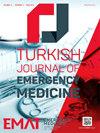新型冠状病毒肺炎插管患者直肌鞘血肿1例报告
IF 1.1
Q3 EMERGENCY MEDICINE
引用次数: 3
摘要
直肌鞘血肿(RSH)是一种危及生命的疾病。它独特的解剖结构背后隐藏着病理学。COVID-19危重患者在等待重症监护住院期间,在急诊科接受更长时间的管理。因此,更复杂的程序,如俯卧位在急诊科进行,以确保病人护理的继续。我们报告了一例需要俯卧位的插管危重COVID-19患者的RSH。在急诊科急症监护室住院期间,她出现贫血、尿毒症和缺氧恶化。紧急对比增强计算机断层扫描导致我们诊断为RSH。她接受了保守治疗和输血。我们想强调这个病例的诊断复杂性,因为这个通气的病人需要生化和放射学标记来诊断RSH,并结合高怀疑水平。有俯卧位和使用抗凝剂等危险因素的患者必须考虑RSH。最后,对危重患者采取全面的治疗方法,不仅有利于患者,也有利于医疗保健行业。护理方向应根据患者的病情、影像学和医院资源来决定。本文章由计算机程序翻译,如有差异,请以英文原文为准。
A case report on rectus sheath hematoma in an intubated COVID-19 patient
Rectus sheath hematoma (RSH) is a life-threatening condition. Its pathology lies behind its unique anatomy. Critically ill COVID-19 patients are managed in the emergency department for longer periods while awaiting critical care admission. Therefore, more complex procedures such as prone positioning are performed in the emergency department to ensure patient care continues. We report this case of RSH in an intubated critically ill COVID-19 patient requiring prone position. During her stay in the Emergency Department Acute Care Unit, she developed anemia, uremia, and worsening hypoxia. Emergency contrast-enhanced computed tomography leads to our diagnosis of RSH. She was treated with a conservative approach and blood transfusion. We would like to highlight this case for its diagnostic complexity since this ventilated patient required both biochemical and radiological markers to diagnose RSH in combination with high suspicion levels. RSH must be considered in patients with risk factors such as prone position and anticoagulant usage. Last, a holistic approach to critically ill patients will not only benefit patients but also health-care profession. The direction of care should be decided based on the patient's condition, imaging, and hospital resources.
求助全文
通过发布文献求助,成功后即可免费获取论文全文。
去求助
来源期刊

Turkish Journal of Emergency Medicine
EMERGENCY MEDICINE-
CiteScore
1.70
自引率
0.00%
发文量
30
审稿时长
22 weeks
期刊介绍:
The Turkish Journal of Emergency Medicine (Turk J Emerg Med) is an International, peer-reviewed, open-access journal that publishes clinical and experimental trials, case reports, invited reviews, case images, letters to the Editor, and interesting research conducted in all fields of Emergency Medicine. The Journal is the official scientific publication of the Emergency Medicine Association of Turkey (EMAT) and is printed four times a year, in January, April, July and October. The language of the journal is English. The Journal is based on independent and unbiased double-blinded peer-reviewed principles. Only unpublished papers that are not under review for publication elsewhere can be submitted. The authors are responsible for the scientific content of the material to be published. The Turkish Journal of Emergency Medicine reserves the right to request any research materials on which the paper is based. The Editorial Board of the Turkish Journal of Emergency Medicine and the Publisher adheres to the principles of the International Council of Medical Journal Editors, the World Association of Medical Editors, the Council of Science Editors, the Committee on Publication Ethics, the US National Library of Medicine, the US Office of Research Integrity, the European Association of Science Editors, and the International Society of Managing and Technical Editors.
 求助内容:
求助内容: 应助结果提醒方式:
应助结果提醒方式:


